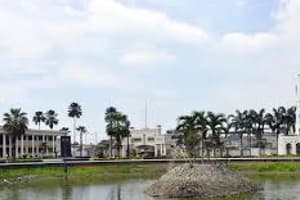Podcast
Questions and Answers
What part of the flower produces and holds pollen?
What part of the flower produces and holds pollen?
- Stamen
- Anther (correct)
- Filament
- Pistil
A perfect flower has either the pistil or the stamen.
A perfect flower has either the pistil or the stamen.
False (B)
What is the process called when a seed grows into a new plant?
What is the process called when a seed grows into a new plant?
Germination
The sticky surface at the top of the pistil is called the ______.
The sticky surface at the top of the pistil is called the ______.
Match the plant types to their descriptions:
Match the plant types to their descriptions:
Which type of pollination occurs when pollen is transferred from one flower to another on a different individual plant?
Which type of pollination occurs when pollen is transferred from one flower to another on a different individual plant?
Hydrophytes are plants that live on land.
Hydrophytes are plants that live on land.
What is the female part of the flower called?
What is the female part of the flower called?
Flashcards
Petals
Petals
The colorful parts of a flower that attract pollinators.
Stamen
Stamen
The male reproductive part of a flower, consisting of an anther and a filament.
Anther
Anther
The part of the stamen that produces and holds pollen.
Filament
Filament
Signup and view all the flashcards
Pistil
Pistil
Signup and view all the flashcards
Stigma
Stigma
Signup and view all the flashcards
Self-pollination
Self-pollination
Signup and view all the flashcards
Cross-pollination
Cross-pollination
Signup and view all the flashcards
Study Notes
Parts of a Flower
- Petals: Colored parts of a flower, often noticeable.
- Stamen: The male part of the flower.
- Anther: Produces and holds pollen.
- Filament: A stalk that supports the anther.
- Pistil: The female part of the flower.
- Stigma: Sticky surface at the top of the pistil, traps and holds pollen.
- Style: Tube-like structure that holds up the stigma.
- Ovary: Enlarged basal portion of the pistil, containing ovules.
- Ovule: Contains the female reproductive cells.
- Sepal: Outer, often green and leaf-like parts of the flower that enclose developing buds.
- Receptacle: The part of the flower stalk where flower parts attach.
Flower Structure
- Perfect Flower: Has both pistil and stamen.
- Imperfect Flower: Has either a pistil or a stamen.
Pollination
- Pollination: Transferring pollen grains from the anther to the stigma.
Self-Pollination
- Self-Pollination: When pollen from the anther is deposited on the stigma of the same flower or another flower on the same plant.
Cross-Pollination
- Cross-Pollination: Transfer of pollen from the anther of one flower to the stigma of another flower on a different individual of the same kind of plant.
Fertilization
- Fertilization: Pollen from a flower meets with the ovule in the female part (pistil) and forms seeds.
Parts of a Fruit
- Pericarp: The fruit wall.
- Exocarp: Outer layer of the fruit.
- Mesocarp: Middle layer of the fruit.
- Endocarp: Inner layer of the fruit.
- Seed: Develops from the ovule after fertilization.
Life Cycle of a Plant
- Seed: Starts the cycle.
- Sprout: Growing from seed.
- Seedling: Growing plant from sprout.
- Plant: Fully developed plant.
Germination
- Germination: Process where a seed grows into a new plant.
Needs of Plants
- Light
- Gases from the air
- Room to grow
- Nutrients
- Water
- Correct temperature
Plant Classification
- Classified by Structure
- Classified by Habitat
Plant Types
- Trees: Tall plants with big woody stems.
- Shrubs: Shorter than trees with woody stems.
- Vines: Plants with thin long stems that climb up walls or trees, sometimes crawling on the ground.
- Herbs: Fleshy stems that can be easily cut, some can be eaten or used as medicine.
- Grass: Plants with blade-like leaves, low, green, and non-woody plants.
- Xerophytes: Plants that live on land.
- Hydrophytes: Plants that live on water.
- Epiphytes: Plants that grow on the surface of another plant.
Studying That Suits You
Use AI to generate personalized quizzes and flashcards to suit your learning preferences.




